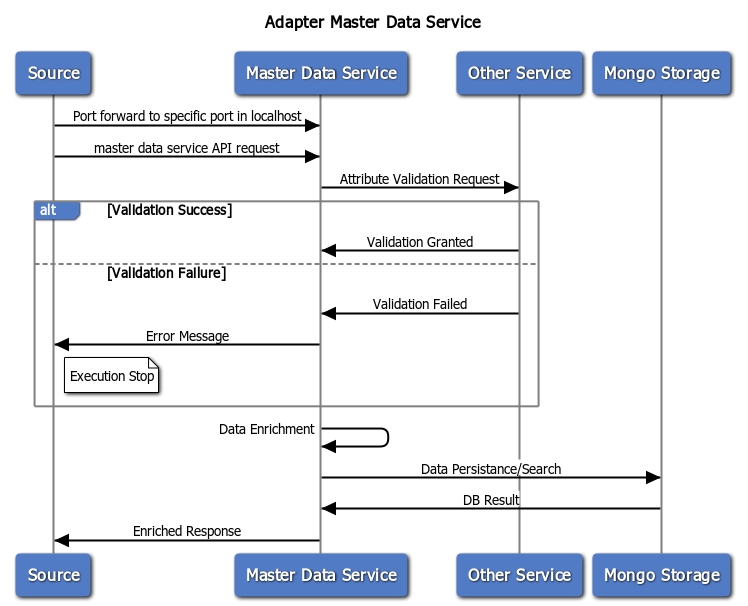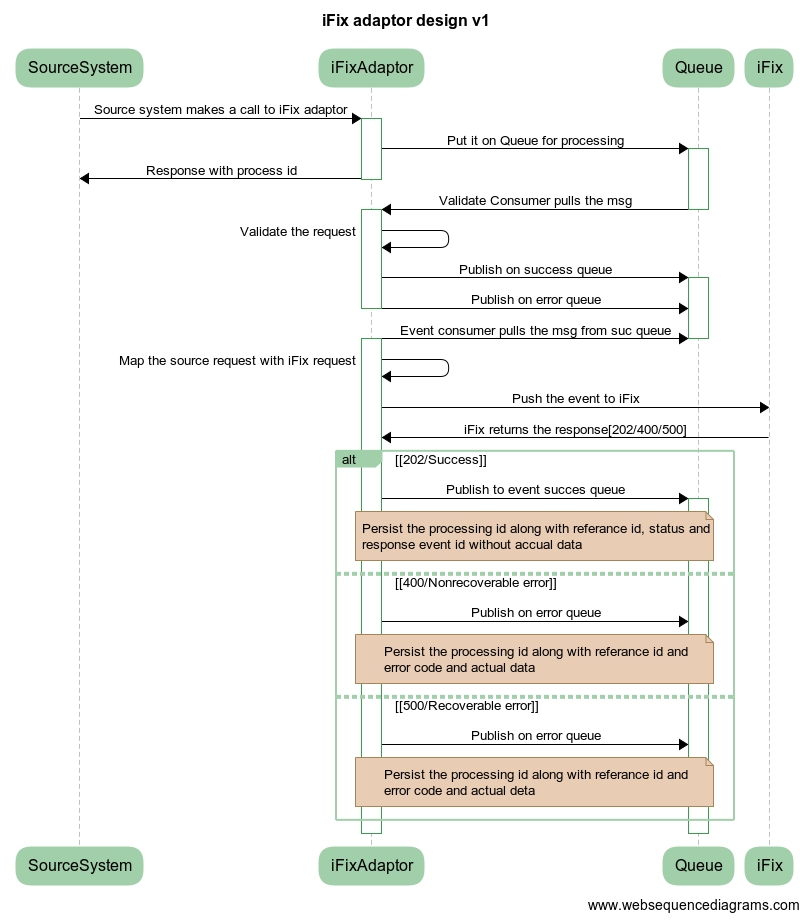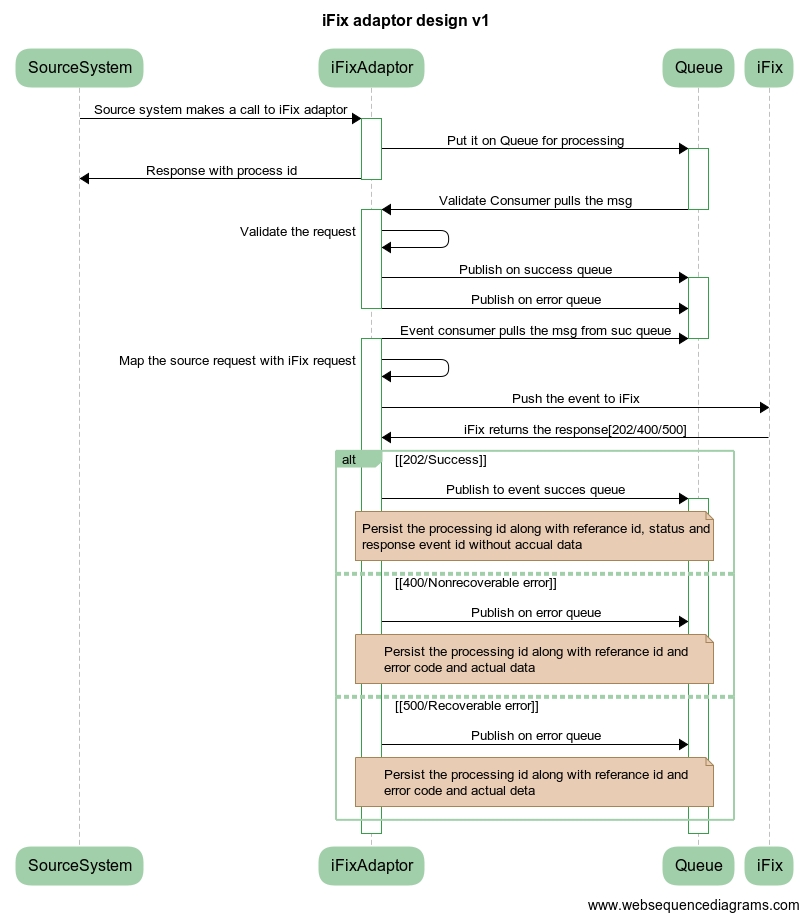Ifix-Adapter is a system that works as a mediator between iFIX and its clients. This system will receive requests from the client system and convert the data in the iFIX required format This document contains the details on how to set up the iFIX-adapter service and describes the functionalities it supports. It supports multiple events (Event Array) in a single request.
Before you proceed with the configuration, make sure the following pre-requisites are met -
Java 8
The Kafka server is up and running
The PSQL server is running
Redis
The following services should be up and running:
Client Service Like mgramseva-ifix-adapter
Target service IFIX- fiscal-event-service
Target Service IFIX-keycloak
Adapter master data service
IFIX client requests are pushed to IFIX.
The authentication token is fetched from keycloak and cached. Token is re-fetched 5 minutes before expiry.
project_id from request data is getting treated as Department Entity Code to fetch Department Entity.
COA Code fetched from COA Mapping table by client code and cached it in Redis Server.
Every push to IFIX is recorded in the table with HTTP status
status series 200 considered success
status 400 are marked client error
It collects projectId form request data, treats it as department_entity_code and calls search API to Department Entity Service. It always expects it will receive only one Department Entity against a single department_entity_code, if it finds multiple raises an error message.
One project can have multiple department entities but vice-versa cannot be true. In case of multiple projects for one department entity - the system will raise an error message.
Deploy the latest version of the ifix-reference-adapter.
kafka.topics.ifix.adaptor.mapper
Topic in which client requests are put. From this further listen and posting happens
keycloak.host
Host name of the key cloak authentication token provider
keycloak.token.url
key cloak authentication token url
keycloak.credentials.clientid
userid of for authentication token
keycloak.credentials.clientsecret
password for authentication token
ifix.host
host name of IFIX server
ifix.event.url
IFIX post URL
spring.redis.host
Host name of the redis server
state.goverment.code
top level tenant id of the client
spring.jpa.properties.hibernate.dialect
dialect for JPA. you can change this to oracle or my sql etc
spring.jpa.properties.hibernate.jdbc.lob.non_contextual_creation
will generate the required tables in the respective database . This feature is used instead of flyway to get database in-dependency
Map clientcode, ifixcoacode, ifixid in ifix_adapter_coa_map table
“clientcode” is the tax head like “WATER_CHARGES” or ‘10011’ used in IFIX clients like mgramseva
“ifixcoacode” is the 16 digit glcode in IFIX. 16-digit code is mapped then this can be ported to any environment like dev to qa, or qa to uat or from uat to prod. Prefer mapping ifixcoacode
an example is INSERT INTO public.ifix_adapter_coa_map(id, clientcode, ifixcoacode, ifixid, tenantid) VALUES (1,'10101', '0215-01-102-00-00-01', '6cbcb4a1-2431-4f78-89d7-b4f0565aba37', 'pb');
state.goverment.code set this value to the client top level tenant_id
API Swagger document
Postman
events/v1/_push
API for receiving data from client (mgram). This is the only API present in the adapter
The adapter master data service maintains information on Departments, Expenditures and Projects. We can create these details and search for the same details based on the given parameters/request data.
Current version: 1.0.0
Before we proceed with the configuration, make sure the following pre-requisites are met
Java 8
MongoDB instance
Required service dependency - Department entity service
It creates secure endpoints for the master data service. The access token is required to create any master data. The subsequent sections on this page discuss the service details maintained by the master data service.
Maintains the creation and search department details. The following information is passed while creating the department - the Government ID, department code, department name, parent department if any. Searching the department details is on given parameters like IDs, Government IDs, department codes, and department names.
/department/v1/_create
/department/v1/_search
Maintains the expenditure details And provides create and search functionality. For creating the expenditure, the following details are required - the Government ID, the department ID, code, name, and type (can be "SCHEME", or "NON_SCHEME") details. While searching the expenditure details, pass the given parameters like IDs, Government IDs, names and codes.
/expenditure/v1/_create
/expenditure/v1/_search
Maintains the project details and provides create and search functionality. The following details are required to create the project - Government, name, code, expenditure ID, department entity ID(s) and location IDs. While searching, pass the IDs, Government ID, name, code, expenditure ID and location ID.
/project/v1/_create
/project/v1/_search
No environment-specific variables are required for the environment (migration).
Update the DB and URI configurations in the dev.yaml, qa.yaml, prod.yaml file.
Swagger Yaml
Postman collection
Project Create API creates the project when the Master data details (COA, Government, Expenditure, Department) and Department Entity have been created. COA And Government have to be created in iFIX core Master data service.
Project Create API takes the below attributes in request :
tenantId: This is the ID that will be defined while creating the Ifix core Master Government Service.
expenditureId: This is the ID that will be generated while creating the Adapter Master Expenditure Service.
code: This is the project code that needs to be created.
name: This is the project name that needs to be created.
departmentEntityIds: This is the Department Entity Ids. If we have to create a project at hierarchy level 1 then we need to pass the Department Entity Id of that corresponding level. It depends on the Department hierarchy level on which the project has to be created and hence the same level Department Entity Id. You can pass a list of departmentEntityIds and can create the same project.
Below is an example of a dummy project using create API.
Request :
Response:
Ifix-Adapter is a system that works as a mediator between iFix and its clients. This system will receive requests from the client system and convert the data in the Ifix required format. This document contains details about how to set up ifix-adapter service and describes the functionalities it provides.
Before you proceed with the configuration, make sure the following pre-requisites are met -
Java 8
The Kafka server is up and running
The PSQL server is running
Redis
The following services should be up and running:
Client Service Like mgramseva-ifix-adapter
Target service IFIX- fiscal-event-service
Target Service IFIX-keycloak
IFIX master-data-service
IFIX client requests are pushed to IFIX
The authentication token is fetched from keycloak and cached. Token will be re-fetched 5 minutes before expiry
the project ID is fetched from IFIX and cached
COA ID fetched from IFIX and cached
Every push to IFIX is recorded in the table with HTTP status
status series 200 is considered a success
status 400 are marked client error and reported back to the client
status 500 resubmitted by the scheduler
Deploy the latest version of ifix-reference-adapter
kafka.topics.ifix.adaptor.mapper
Topic in which client requests are put . From this further listen and posting happens
keycloak.host
Host name of the key cloak authentication token provider
keycloak.token.url
key cloak authentication token url
keycloak.credentials.clientid
userid of for authentication token
keycloak.credentials.clientsecret
password for authentication token
ifix.host
host name of IFIX server
ifix.event.url
IFIX post URL
spring.redis.host
Host name of the redis server
state.goverment.code
top level tenant id of the client
ifix.coa.search.url
url for COA search in IFIX
ifix.project.search.url
Url for the project code search in IFIX
spring.jpa.properties.hibernate.dialect
dialect for JPA. you can change this to oracle or my sql etc
spring.jpa.properties.hibernate.jdbc.lob.non_contextual_creation
will generate the required tables in the respective database . This feature is used instead of flyway to get database in-dependency
Map clientcode, ifixcoacode, ifixid in ifix_adapter_coa_map table
“clientcode” is the tax head like “WATER_CHARGES” or ‘10011’ used in IFIX clients like mgramseva
“ifixcoacode” is the 16 digit glcode in IFIX. 16-digit code is mapped then this can be ported to any environment like dev to qa, or qa to uat or from uat to prod. Prefer mapping ifixcoacode
Another way is to map the IFIX COA ID itself. Since these are generated ids you can't port to other environments. ID mapping has to be done for every environment.
Preference is given to COA Code, if it is null ID will be used
example is INSERT INTO public.ifix_adapter_coa_map( id, clientcode, ifixcoacode, ifixid, tenantid) VALUES (1,'10101', '0215-01-102-00-00-01', '6cbcb4a1-2431-4f78-89d7-b4f0565aba37', 'pb');
If client “project code” and IFIX project code are the same then no need for mapping. If it is different then map clientprojectcode, ifixprojectid in ifix_adapter_project_map table. Ideally, you should keep both codes the same for getting meaningful data on the dashboard. This way you don't have to do any mapping for project code for any environment. But if for any reason you have different project codes in IFIX and its client or have multiple projects having the same project code then only go for this mapping. The adapter will first check in the IFIX for the supplied “projectCode”, If found it will be used and cached. If multiple projects or not found it will look into this table for mapping
an example is INSERT INTO public.ifix_adapter_project_map( id, clientprojectcode, ifixprojectid, tenantid) VALUES (1, '7374', 'e42db9bb-8427-40a6-9939-4f2189d032bf','pb');
state.goverment.code set this value to the client top level tenantid
Api Swagger document
Postman
events/v1/_push
API for receiving data from the client (mgram). This is the only API present in the adapter
Follow the steps below to create the Adapter Master Data. Individual Adapter Service setup and configuration documents can be .
Enter valid details along with Tenant ID to create the Department. Once the tenant ID is created, the user receives a response with an ID and related details. This ID is the Department ID.
Enter valid details along with the Tenant ID to create the Expenditure. Once the tenant ID is created, the user receives a response with an ID and related details. This ID is the Expenditure ID.
Enter valid hierarchy details of the Master Department to create a Department Hierarchy.
Provide valid details to create a Department Entity.
On successful completion of steps 1 to 4, enter valid details to create a project.


